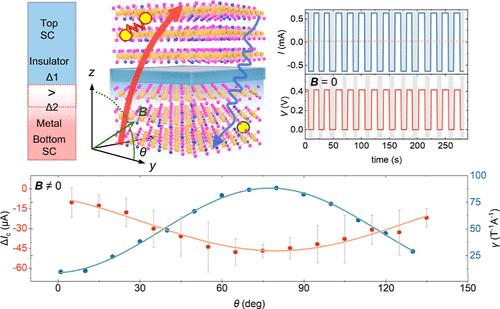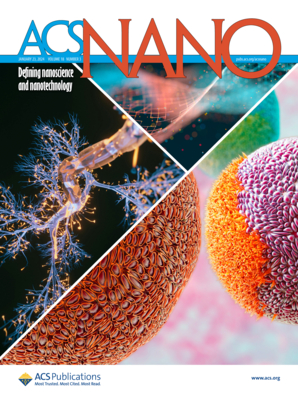Field-Free Superconducting Diode Effect and Magnetochiral Anisotropy in FeTe0.7Se0.3 Junctions with the Inherent Asymmetric Barrier
IF 15.8
1区 材料科学
Q1 CHEMISTRY, MULTIDISCIPLINARY
引用次数: 0
Abstract
Nonreciprocal electrical transport, characterized by an asymmetric relationship between the current and voltage, plays a crucial role in modern electronic industries. Recent studies have extended this phenomenon to superconductors, introducing the concept of the superconducting diode effect (SDE). The SDE is characterized by unequal critical supercurrents along opposite directions. Due to the requirement on broken inversion symmetry, the SDE is commonly accompanied by electrical magnetochiral anisotropy (eMCA) in the resistive state. Achieving a magnetic-field-free SDE with field tunability is pivotal for advancements in superconductor devices. Conventionally, field-free SDE has been achieved in Josephson junctions by intentionally intercalating an asymmetric barrier layer. Alternatively, internal magnetism was employed. Both approaches pose challenges in the selection of superconductors and fabrication processes, thereby impeding the development of SDE. Here, we present a field-free SDE in FeTe0.7Se0.3 (FTS) junction with eMCA, a phenomenon absent in FTS single nanosheets. The field-free property is associated with the presence of a gradient oxide layer on the upper surface of each FTS nanosheet, while eMCA is linked to spin splitting arising from the absence of inversion symmetry. Both SDE and eMCA respond to magnetic fields with distinct temperature dependencies. This work presents a versatile and straightforward strategy for advancing superconducting electronics.

具有固有不对称势垒的 FeTe0.7Se0.3 结中的无场超导二极管效应和磁手性各向异性
以电流和电压之间的不对称关系为特征的非互易电气传输在现代电子工业中发挥着至关重要的作用。最近的研究将这一现象延伸到了超导体,引入了超导二极管效应(SDE)的概念。SDE 的特点是沿相反方向的临界超电流不相等。由于需要打破反转对称性,SDE 通常伴随着电阻态的电磁手性各向异性(eMCA)。实现具有磁场可调性的无磁场 SDE 对于超导体设备的发展至关重要。传统上,约瑟夫森结中的无磁场 SDE 是通过有意插入非对称阻挡层来实现的。另外,还采用了内部磁性。这两种方法都对超导体的选择和制造工艺提出了挑战,从而阻碍了 SDE 的发展。在这里,我们展示了在 FeTe0.7Se0.3(FTS)结中使用 eMCA 的无场 SDE,这是 FTS 单纳米片所不具备的现象。无场特性与每个 FTS 纳米片上表面存在的梯度氧化层有关,而 eMCA 则与不存在反转对称性而产生的自旋分裂有关。SDE 和 eMCA 对磁场的响应都具有明显的温度依赖性。这项工作为推进超导电子学的发展提供了一种通用而直接的策略。
本文章由计算机程序翻译,如有差异,请以英文原文为准。
求助全文
约1分钟内获得全文
求助全文
来源期刊

ACS Nano
工程技术-材料科学:综合
CiteScore
26.00
自引率
4.10%
发文量
1627
审稿时长
1.7 months
期刊介绍:
ACS Nano, published monthly, serves as an international forum for comprehensive articles on nanoscience and nanotechnology research at the intersections of chemistry, biology, materials science, physics, and engineering. The journal fosters communication among scientists in these communities, facilitating collaboration, new research opportunities, and advancements through discoveries. ACS Nano covers synthesis, assembly, characterization, theory, and simulation of nanostructures, nanobiotechnology, nanofabrication, methods and tools for nanoscience and nanotechnology, and self- and directed-assembly. Alongside original research articles, it offers thorough reviews, perspectives on cutting-edge research, and discussions envisioning the future of nanoscience and nanotechnology.
 求助内容:
求助内容: 应助结果提醒方式:
应助结果提醒方式:


